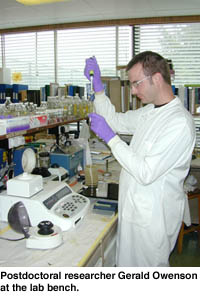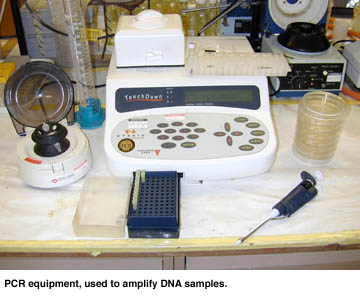


by Martyn Amos and Gerald G. Owenson
The recent completion of the first draft of the human genome has led to an explosion of interest in genetics and molecular biology. The view of the genome as a network of interacting computational components is well-established, but researchers are now trying to reverse the analogy, by using living organisms to construct logic circuits.
The cellular computing project is the result of collaboration between teams at the University of Liverpool (Alan Gibbons, Martyn Amos and Paul Sant) and the University of Warwick (David Hodgson and Gerald Owenson). The field emerged in 1994 with the publication of Adleman’s seminal article, in which he demonstrated for the first time how a computation may be performed at a molecular level. Our group contributed to the development of the area by describing a generalization of Adleman’s approach, proposing methods for assessing the complexity of molecular algorithms, and carrying out experimental investigations into error-resistant laboratory methods. This work quickly confirmed that the massively-parallel random search employed by Adleman would greatly restrict the scalability of that approach. We therefore proposed an alternative method, by demonstrating how Boolean logic circuits may be simulated using operations on strands of DNA.
Our original intention was to implement the Boolean circuit in vitro (ie in a laboratory ‘test tube’). However, after much consideration we decided to attempt a rather more ambitious approach, harnessing genetic regulatory mechanisms in vivo, within the living E. coli. bacterium.
The central dogma of molecular biology is that DNA (information storage) is copied, producing an RNA message (information transfer). This RNA then acts as the template for protein synthesis. The basic ‘building blocks’ of genetic information are known as genes. Each gene codes for a specific protein which may be turned on (expressed) or off (repressed) when required. In order for the DNA sequence to be converted into a protein molecule, it must be read (transcribed) and the transcript converted (translated) into a protein. Each step of the conversion from stored information (DNA) to protein synthesis (effector) is itself affected or catalyzed by other molecules. These molecules may be enzymes or other compounds (for example, sugars) that are required for a process to continue. Consequently, a loop is formed, where products of one gene are required to produce further gene products, and may even influence that gene’s own expression.
The interaction of various components of the E. coli genome during development may be described in terms of a logic circuit. For example, a gene’s expression may require the presence of two particular sugars. Thus, we may view this gene in terms of the Boolean AND function, where the presence or absence of the two sugars represent the two inputs to the function, and the expression or repression of the gene corresponds to the function’s output. That gene’s product may then be required for the expression (or repression) of another different gene, so we can see how gene products act as ‘wires’, carrying signals between different ‘gates’ (genes).
In order to implement our chosen logic circuit, we select a set of genes to represent gates, ensuring that the inter-gene dependencies correctly reflect the connectivity of the circuit. We then insert these genes into a bacterium, using standard tools of molecular biology. These insertions form the most time-consuming component of the entire experimental process, as the insertion of even a single gene can be problematic. However, once the entire set of genes is present in a single colony of bacteria we have an unlimited supply of ‘biological hardware’ at our disposal. The inputs to the circuit are set by enforcing in the cell’s environment the presence or absence of various compounds that affect the expression of the genes representing the first level gates. Then, essentially, the development of the cell and the complex regulatory processes involved, simulate the circuit, without any additional human intervention. This last point is crucial, as most existing proposals for molecular computing require a series of manipulations to be performed by a laboratory technician. Each manipulation reduces the probability of success for the experiment, so the ideal situation is a ‘one-pot’ reaction, such as the one we propose.


We have recently begun work on simulating a small (3 gate) circuit of NAND gates in vivo. We believe that, within the next three years, the introduction of human-defined logic circuits into living bacteria will be a reality. Of course, such implementations will never rival existing silicon-based computers in terms of speed or efficiency. However, our goal differs from that of a lot of groups in the community, who insist that DNA-based computers may eventually rival existing machines in domains like encryption. Rather, we see the potential applications of introducing logic into cells as lying in fields such as medicine, agriculture and nano-technology. The currenct ‘state of the art’ in this area has resulted in the reprogramming of E. coli genetic expression to generate simple oscillators. This work, although ‘blue sky’ in nature, will advance the field to a stage where cells may be reprogrammed to give them simple ‘decision making’ capabilities.
Our group is a member of the European Molecular Computing Consortium (see article in this issue). We acknowledge the support of the BBSRC/EPSRC Bioinformatics Programme.
Links:
Publications: http://www.csc.liv.ac.uk/~martyn/pubs.html
The Warwick group: http://www.bio.warwick.ac.uk/hodgson/index.html
EMCC: http://www.csc.liv.ac.uk/~emcc
Please contact:
Martyn Amos - School of Biological Sciences and Department of Computer Science, University of Liverpool
Tel: +44 1 51 794 5125
E-mail: mamos@liv.ac.uk
or Gerald G. Owenson - Department of Biological Sciences, University of Warwick
Tel: +44 2 47 652 2572
E-mail: G.Owenson@warwick.ac.uk